How To Make Chocolate In Little Alchemy

How to Make Chocolate
SCROLL Down
How to Make Chocolate
Making Chocolate At Dwelling: 101
THIS IS THE SHORT, FAST, WHAT You lot NEED AND HOW It HAPPENS GUIDE TO GET You GOING IN THE Correct DIRECTION.
Making Chocolate At Dwelling house: 101
THIS IS THE SHORT, FAST, WHAT Yous NEED AND HOW IT HAPPENS GUIDE TO Become You lot GOING IN THE RIGHT Management.
Equipment list:
Roaster:
It'due south possible to utilise your own oven, some varieties of coffee roasters across the Behmor, a pan on top of your stove, a modified pop corn popper -- similar to coffee roasting it depends on how much experimentation vs equipment you lot want.
Tip:The Alchemist uses his habitation built one or a Behmor currently.
Not bad the Beans:
I like the Champion Juicer to crack beans. Information technology'due south fast and efficient. And gives you double duty since information technology tin also make roasted nibs into liquor. Peeling past hand is low tech and the style it was done long ago (and in some origins), takes a while, and may be more or less efficient for winnowing at the same time depending on your technique. It'south less efficient on time.
Winnowing:
The everyman tech method (later on hand peeling) is a hair dryer prepare to cold, or a small store vac set to accident; over a large bowl of nibs and husks. The basin is circulated with a tossing motion of the paw bringing nibs and husks up slightly into the air, giving the husks a adventure to blow away. Afterward that, at that place is the hand fed Sylph or the automatic Aether.
Grinding:
Champion Juicer: there doesn't seem to exist a good substitute for this one however. With a small amount of nibs you can skip the grinding stage and become straight to the Melanger, but the bigger your batch the harder that is. You lot lose a fix corporeality every time you put cocoa beans through the Champion -- six ounces (half dozen oz) no matter what weight you are processing.
Refining/Conching:
You demand a Melanger. Either the Spectra eleven for dwelling house use or ane of the larger ones if you need more. There's not a domicile substitute for this one either. This is the heavy granite slab with granite wheels that crunches the lumpy cocoa liquor (along with your other dry ingredients and extra cocoa butter, depending on what you're making) into something you'll want to paw to your friends and grandma.
-
Calibration:
The Alchemist uses and sells an Escali scale. In order to measure your ingredients, rather than putting them into a measuring cup, they need to be weighed. Wet (cocoa liquor and melted cocoa butter) and dry out (sugar, powered milk if you're making milk chocolate) all become weighed. This is a mass not volume concern. Cocoa butter and cocoa liquor unfortunately don't come with smashing little lines on their wrappers to tell you lot how much makes a quarter cup. They don't come with wrappers!
Molds:
Molds are optional. If you have them you lot can make your chocolate into pretty little hearts or squares or fishes. Without them you tin pour it into a zip lock bag for storage, onto wax paper in a large puddle which will dry in an uneven canvass that you can break up. An ice cube tray would work for cubes of chocolate. It all depends on what y'all desire to do once you make it.

14 Gratis in depth training videos on Making Chocolate At Home
Edibles
Sugar
makes your chocolate sweet. Must be dry out sugar, not dearest, syrup, etc.
Milk Powder:
Y'all need dry milk if you desire to brand milk chocolate. You tin't use ANY liquid ingredients.
Cocoa beans:
diverseness of your choice. Two pounds is a good amount to start with considering you loose some weight in the winnowing process, and some more when you grind them. If yous don't get them from the Alchemist he won't take sympathy for you if they gustatory modality bad. (the Alchemist is smiling at this as he reads information technology - not that it isn't true)
Cocoa butter:
optional, makes a softer chocolate for eating. You don't accept to have it if you're making baker's chocolate.
Lecithin:
fabricated from soy by and large. Near people think of it as an emulsifier, this is not true for chocolate making. In this instance information technology modifies viscosity, it makes a thinner chocolate. It is often used in place of cocoa butter since it is cheaper, but also isn't a straight replacement.
What to do
Roast your cocoa beans:
then cool them until they are back to room temperature. It'southward easiest to exercise this at to the lowest degree half a day before anything else. A full day would be even meliorate. Roasting cocoa beans often aroma similar blistering brownies. Expect to attract spectators if there are any effectually.
Crack and Winnow the beans:
Either with the Champion without its screen in, or by hand. You feed the beans in the tiptop and the nibs and husk come out the lesser. And then you do the bravado air and tossing nibs part until there is little or no husk left in the beans if you are using a blow drier.. You'll also accept virtually a six foot circumvolve of husk around you. Winnowing is all-time done outdoors, or in an area that's open and easy to sweep up. The kitchen is not such a expert pick. A neater alternative is to utilise the Sylph winnower.
Refine/conch:
Make sure your liquor is still nicely liquid, and put it in your Melanger to turn information technology from the sort of lumpy, gritty stuff to smooth chocolate. Start it running as before long as the cocoa liquor is in, and then add the other ingredients a bit at a time. That fashion the rollers don't take to try to crash-land over a pile of sugar or dry milk. NO H2o BASED LIQUIDS!
If you desire to put in brown saccharide, dry it for a while in your oven. If you're using them, add the cocoa butter, lecithin, sugar, milk powder, etc. Put the lid on and let it go. We don't leave ours running if we aren't home generally. The thing runs from 18 to 48 hours depending on the chocolate and other ingredients. Yous tin can stop it and check how smooth your chocolate is by dipping a spoon in (like tasting batters). If you finish it for a long time it will cool off. You can put the metallic and granite role of the Melanger into a slightly warm oven to warm it back up -- this is slow. The plastic knob won't take much rut -- just 100-150 degrees F for an hour or 2 will remelt the chocolate until the Melanger tin can run over again.
Tempering:
If you desire shiny chocolate y'all take to temper information technology, which takes warming and cooling and making it's construction change. As for all of this, run into the Alchemist's real instructions for how to do it.
Mold your chocolate:
the chocolate'due south smooth and no longer feels grainy. Pour information technology into molds, or whatever final holding device you're using. Clean up for as long as it takes go get all the chocolate off the Melanger and you're done. The molds need to cool for a few hours earlier the chocolate comes out of them.
Accept Questions?
What At present?
As I said at the start. This is quick and dirty. It'southward non meant to teach you lot how to brand chocolate just to give yous an overview.
Read on for the full story.

Cocoa Beans
Cocoa Beans
Cocoa beans have numerous similarities to coffee beans, with some of import differences in processes. They are both fermented (fermented cocoa well-nigh looks already roasted), roasted and ground for use. Cocoa beans come up in 3 primary species, Criollo, Forastero and Trinitario, but there are hundreds of sub-varieties for each. Very loosely, Criollo is analogous to Arabica coffee in that it is the foam of the crop and has the most delicate and circuitous array of flavors. Merely in many cases, this can also mean a very mild chocolate.
The Forastero can exist compared to Robusta coffee in its disease resistance and higher product, but that is where the comparing ends. Where robusta is just horrid 99% of the fourth dimension, Forastero is not like that. It has a stiff full cocoa flavor, but depending on the grade and preparation, tin be rather one dimensional. Well prepared Forastero is what virtually of us are used to eating in chocolate.
Finally, Trinitario is a hybrid of the two, and can have various characters of both parents. Often a Trinitario bean is spoken of every bit having a potent or weak Criollo influence.
Storage
Unless specifically labeled, the cocoa beans or nibs you have purchased in their raw class. They are best kept in a cool, dry out, sealed location. Like this, they should remain "fresh" 6 months to a year. I don't recommend refrigeration or freezing as information technology is like shooting fish in a barrel to trap moisture which is not good for cocoa beans.
I recommend leaving them in their raw form until you are ready to use them. Roasted beans get stale quicker than raw beans, usually with a shelf life of around a month.
Roasted vs Raw
I know in that location is a lot of data out there well-nigh the wellness benefits of chocolate, and I know some people like to swallow cocoa in information technology's raw grade for "maximum" health benefits. Personally, I do not recommend eating ANY cocoa raw. All commercial cocoa beans have been fermented past various yeasts and micro organisms, and are oftentimes open air dried. In add-on, e.coli and Salmonella can exist present on the surface of the husk. Proper roasting completely kills whatever potential surface contamination that may exist present, makes them safe to swallow and develops the flavors associated with chocolate. And proper, frail roasting does non significantly reduce the health benefits of cocoa - after all, the benefits were originally found in finished chocolate, not raw cocoa beans. Continue that in listen.
There is even some debate as to whether the nutrients and various flavonoids are even nutritionally "available" in the raw form since roasting alters the concrete construction of the cocoa bean and makes it easier to grind. If y'all practice want to eat cocoa beans whole as a snack, get correct ahead - just roast them get-go. And if you really don't desire to roast them, delight pare them.
Cocoa Bean Roasting
Cocoa Bean Roasting
Most cocoa beans that y'all volition encounter for chocolate making are fermented, only are not roasted all the same. The fermentation process does darken them upwards considerably and yous may recall they are already roasted, just the lack of an evenness in colour and texture is the key to telling when they are unroasted. Roasting accomplishing a number of things.
-
Information technology helps divide the outer husk from the inner bean and makes corking and winnowing much easier.
-
It likewise virtually sterilizes the cocoa bean. This is rather important every bit the conditions in which cocoa beans are fermented are naturally full of bacteria, fungi and molds. There is a "quantifiable" risk of infection from unroasted cocoa beans. Roasting reduces this risk.
-
Various chemical reactions occur when cocoa beans are roasted and proper roasting is integral to proficient flavored chocolate. The vinegar olfactory property from fermenting is driven off. Raw beans don't taste similar chocolate. Roasted beans do.
Finally, for those of you who have read about the nutritional value of chocolate and cocoa beans, and worry that roasting destroys these nutrients, delight remember that all of the research (to the best of my noesis) has been done on fully roasted, fermented cocoa beans and chocolate. Sure, if you over roast or over process information technology, you may well loose some nutrients, merely I personally take the nutritional benefits of chocolate equally a do good, non a goal. The flavor is my goal at Chocolate Alchemy.
Options for Home Roasting Cocoa Beans
In that location is a ton of information out at that place on the spider web nearly roasting coffee at habitation. If you can roast coffee at home (I do), y'all tin can roast cocoa beans at habitation. Sweet Maria's is a groovy source for coffee roasting information and some supplies.
Unlike coffee, which roasts anywhere from 400-460F, cocoa beans need more than gentle handling. In that in that location are no hard or fast java roasting rules, the same holds truthful for cocoa. In general though, they can be roasted from 5-35 minutes anywhere from about 250-325 F. To practise this, there are basically five options:
-
Oven roasting
-
Air roasting
-
Drum roasting with a gas grill
-
Java roaster (the Behmor is our pick)
-
Hot air gun, believe it or not.
With all of the methods, the basic technique is the same. Subject field the cocoa beans to a loftier temperature initially, slowly reduce the temperature and terminate the roast when the beans are "dandy", but well before they first to burn.
The initial high heat lets the beans proceeds some thermal momentum and allows for a expert separation of the husk and nibs as the beans aggrandize. Yous lower the ambient temperature and then as not to burn the outside of the bean, but permit the interior continue to roast. Finally, the cocoa beans will start to popular and crevice every bit water vapor is explosively released. This happens when the cocoa edible bean temperature is around 250 F. This is your sign you are merely about done roasting. Experience and smell (you don't want any burned olfactory property) are the key indicators when the beans are roasted. Once the cocoa beans are roasted and cooled, try separating the husk from one. If it comes off hands, you did well and the beans are fully roasted. Also, taste some. They should have a nice cocoa flavor, with no raw or burned flavors.
Generally I like to have a roast take xv-20 minutes, regardless of method. Under that amount of fourth dimension and the beans seem to retain a raw unfinished flavour. Over that and they start to taste baked and sort of flat.
Criollo (because they are light in chocolate and fruit) tends to benefit from a more gentle and cease with a lower temperature, where as Forastero MAY need more ambitious roasts with a higher cease temperature when they are big on chocolate and fruit. So far I have had a reasonable degree of success at keeping the roasting under 270 F and stopping the roast earlier the "baking chocolate smell" goes abroad. Overall, don't take them as well hot, but experiment and roast a lot by smell. If it smells like chocolate, you are on the right track.
Oven Roasting
That I am aware of, virtually everyone has an oven in their kitchen, and you can roast cocoa in information technology.
Here is an excerpt from one of my (ancient) logs. You lot can come across how I accept slowly dialed in what temperatures to prepare the oven at and how to accommodate information technology.

Alchemist John'south Oven Cocoa Roasting Log
In general, if y'all effort oven roasting, you volition first hot (350-400 F) for a short amount of time and slowly lower it to your target temperature (275-300 F). This is for well-nigh 2 lb/1 kg of beans. The more than you are roasting, the higher your initial temperature can and has to be and the fourth dimension will probably be a fiddling longer.
Remember, y'all want to roast the cocoa beans, non bake them. This is how that looks:
Whole cocoa beans
375-400 F v minutes
350 F five minutes
325 F five minutes
300 F for 10-15 minutes or until done*. Look for the aroma of baking brownies and/or pops. Both are practiced indicators you are at that place.
*For an even better indicator of a complete roast, apply an infrared thermometer and roast until the beans show 250-260 F. Make sure you stir the beans before taking your reading so y'all don't have a high bias.
If you have nibs, you lot both tin and demand to accept them a little more gentle.
350 F 10 minutes
325 F v minutes
300 F 5 minutes
275 F for 5-x minutes or until washed (once again 250-260 F IR thermometer reading)
That is actually it. Of form, there are LOTS of other ways you can exercise this. I know some people roast at 250 F (or fifty-fifty 220 F) for 45 minutes to an hour or even 2. I am personally non a fan of this fashion, but you may be. And hey, nearly everyone has an oven.
Drum Roasting
If y'all are going to be serious about roasting cocoa beans at home, and/or making chocolate, this is the method I recommend. It has the nigh flexibility, consistency and gives the best overall product for the least amount of work.
Y'all tin can either make your own if yous are inclined or obtain 1 from RK Drums. These are both high quality stainless steel, sell for around $200, and will last a lifetime.
With any of the drums, you volition roast on a gas grill, with a thermometer inserted just beneath the drum and rotate the drum with a by and large bachelor motor or rotisserie that rotates anywhere from vi to 60 rpm.
I pre-heat mine to betwixt 350 - 400 F, and load anywhere from one to iv pounds into my drum. Once the grill is up to temperature, I identify the drum into the grill and start information technology rotating. You will see the temperature drop of l-100 F depending how much you loaded. Resist the urge to turn the temperature upwards. Just permit it come back upward over time. Later about 10 minutes, you should outset to notice a nice brownie aroma and the ambient temperature should exist back in the 300-350 F range. Don't permit it get over 400-425 F equally it tin can start to get out of command as the beans dry.
In another 5 minutes the cocoa beans should showtime to crack. Give them about couple of minutes, smelling, judging and guessing when they are done.
Get your fire proof gloves on (did I forget to mention these?), remove the drum, dump the beans in a waiting bowl, and stir until just warm to the touch on.
This is what a previous (circa 2005) non-likewise-glamorous setup looked similar. The drum very comfortably roasts 3 lb and could probably practise as much as 4 lb or equally little as one.


Pulsate roaster on the grill all loaded with 3 lb of Ocumare
Dumping the beans after a 13 minutes roast


All cool and waiting for the next batch
These are a little nighttime on the outside (see below why), simply actually fine inside
This was my third batch and actually, this roast got a little out of control. The collar holding the drum closed slipped (now it has a new neckband) and some beans dropped in causing a very smoky fire, hence the sooty appearance on the beans. Since I consider this just about the worst I could practice, I figured I would go ahead and process these into chocolate and see merely how information technology comes out. Information technology is ofttimes said that cocoa beans have a narrow window of good roasting, simply these tasted pretty expert. Mostly, they are non pleasing to the centre. By the time everything had rested, mellowed and melded, the chocolate was just fine with no hints of smoke or off flavors.
Coffee Roaster
There are only two off the shelf java drum roasters that I know of that can exercise a reasonable corporeality of cocoa beans on a modest scale. The Behmor 1600 and the Hot Top. Between the 2, there is just really isn't whatever contest. The Hottop will do 6-eight oz of cocoa, maybe 12 oz if you button it. The Behmor 1600 plus can do ii-2.5 lbs.
With both of them you will demand to approximate when the beans are finished and terminate the roast manually as they are programmed for java. I accept not had the opportunity to experiment with the Hot pinnacle in a number of years, so I tin can't actually speak about information technology's current level of programming. The Behmor on the other hand, I have worked with a lot. It has v roast profiles, that are all suitable for cocoa roasting.
Now, in the same way you tin can use a Behmor 1600 Plus, yous can use pretty much whatsoever commercial drum java roaster if you have the use of 1. At that place is no cantankerous contagion of taste either. I roast coffee and cocoa in the same roaster and both sense of taste as they should. I personally use an former Purple #v which runs off propane and tin handle xv lbs of coffee. Only because cocoa roasts so much cooler than coffee, I routinely roast 30-35 lbs of cocoa.
Every bit a crude temperature profile, I pre-oestrus to 350-400 F, and drib in my cocoa. With a thermometer in the bean mass, the temperature unremarkably drops to the low 100's. I then roast, adjusting my heat, to reach 250-260 F over about 13-18 minutes. Yours of form may vary, but every bit a bench mark, for me, the beans just showtime to fissure in this temperature window. So if yours shows 300 F or 240 F, fine, that is roughly your 'new' target temperature in 13-eighteen minutes. And those time and temperatures are not set in stone - they are to give you a guideline to piece of work with, and then adjust off of after you have fabricated it into chocolate. Too sour? Endeavor a lilliputian longer and/or hotter. A little acrid? Try dropping your terminal temperature a bit. To acidic and acrid? Roast it a fleck longer (to reduce acidity) only do information technology more gently (to reduce the acridness). Get the thought? Hopefully so.
Contour Drum Roasting
I take adult a method of Profile roasting cocoa that is remarkable like to the profiles used past coffee roasters. You have a drying, flavor development and finishing phase.

In lieu of repeating (for now) what I have written in great particular, I recommend y'all go read Ask the Alchemist 200 through 206. I go into each phase in bang-up detail and how yous can adjust each i to reliably alter the flavor profile of your chocolate to conform your tastes.
I want to brand it VERY CLEAR this is about Drum roasting and can NOT be applied to oven (even convection) roasting.
Air Roasting
This is only kind of an option for roasting cocoa beans. I mention information technology but because I use a modified W bend popcorn popper to roast my java in at habitation, and for a couple of ounces of cocoa beans, it works well enough.
It is not really a practical way to roast a large (or fifty-fifty a moderate) amount of cocoa beans and nibs tend to wing out.
Regardless, what I exercise is toss in a couple of ounces, plow on the rut, and watch the beans swirl around. In 3-five minutes, they are usually keen very loudly and I turn it off and absurd them down. Adept enough for token evaluation purposes just information technology is a piffling to fast and hot for a proper roasting.
Hot Air gun
This once again is from the realm of java roasting. It is not high tech, but it gets the task done. Basically, place i-ii lbs of cocoa into a shallow bowl (the coffee roasters employ a dog bowl, actually), use the heat gun to oestrus the beans, while you manually stir them. In the same vein every bit before, add a lot of heat initially, back off every bit the roast progresses, and stop when cracks are happening and information technology even so smells like baking brownies.
I will be updating this item method as I get more experience.
Cocoa Edible bean Cracking and Winnowing
Cocoa Bean Cracking and Winnowing
To make chocolate, this husk must be removed from the cocoa bean.
The goal hither is to crevice the cocoa beans into pieces and and so divide (winnow) the husk from the nib.
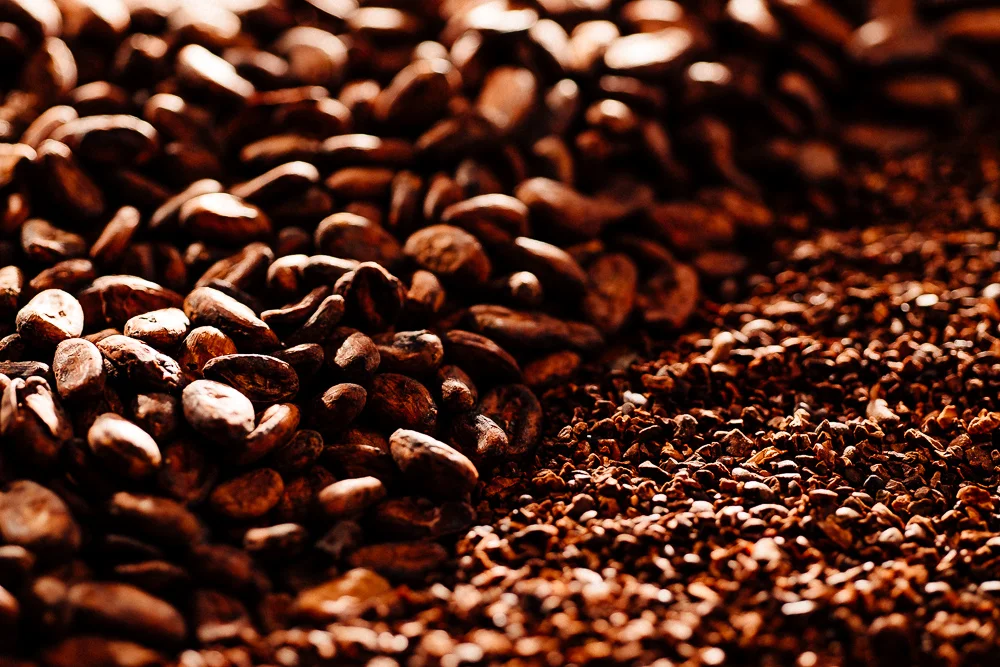
The goal is to go from whole beans to nibs.
Cracking
It can be done by hand, but this is rather tedious and not very approachable. Similar almost things, at that place are many things that exercise not work, and only a few that do work. Hither's a bones list of various ways you tin can and can not crack cocoa beans.
Exercise not work for Cracking:
- Meat Grinders
- Food processors
- Grain mills
- Coffee grinders
Works OK, but not bully or non feasible
- Hand peeling
- Corona type
Works Great
- Champion Juicer w/o lesser screen (run across it fastened to the Aether below)
- Palatial Cracker - a stainless steel and brass cracker build for the Aether for extended lifetime and faster smashing.
Afterward proper roasting, you will notice the outer husk is much looser and easier to remove. Information technology sounds uncomplicated enough but just a few years agone, there were no equipment that worked off the shelf. I contacted two companies to encounter if they had any interest in modifying i of their products to handle cocoa beans. Crankandstein worked with Chocolate Abracadabra and the Crankandstein Cocoa mill was born - a heavy iii roller, dual drive, set gap mill. Sadly they decided to stop making them.
At this signal I tin recommend the Champion Juicer for groovy both raw and roasted cocoa beans.
Winnowing
Later your beans are crack, you and then demand to split up them husk and pecker. In exactly the same vein as corking, at that place are a range of things that work and don't work.
Does not work well:
- Champion Juicer - years ago I proposed separating (not really winnowing every bit no air is involved) the husk and nib as you grind. I technically will work if y'all are doing small 1-2 lb batches, just it is VERY hard on the Champion and the cocoa and not something I generally recommend any more. It's fine for a final filter (see below) just not the initial separation.
Works ok, but not great:
- Long tube PVC winnowers. There are various permutations of these winnowers. Some have one fan, some take two, some have speed controllers, some have valves, near (maybe all) are manus feed. Nigh work well for seeds, but none piece of work simple and piece of cake with a single pass and without a LOT of hands on user intervention.
- Manus peeling - 1 lb/ hour. 'nuff said. Well, I will say more than. Works fine, simply is slow, tedious, hard on the hands and not outgoing.
Works Good:
- Basin/Accident dryer Method
Works Bang-up:
- Sylph winnower
- Aether Winnower
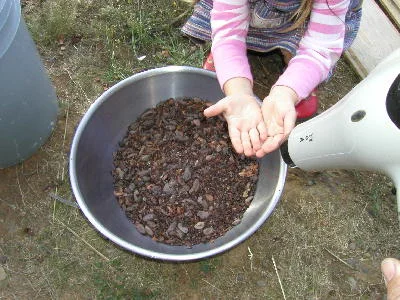
Winnowing the cocoa beans with a pilus dryer
Bowl/Blow dryer Method
The goal here is to blow the lighter husk away only leave the heavier nibs. It's a bit messy, and not good of indoors, but does a fine job. I recommend wearing a grit mask. In that location is definitely user technique involved. Once y'all detect that technique, you can expect to do well-nigh 0.75-one lb/infinitesimal.

iii-4 minutes later, merely over iii lb of Homemade Cocoa Nibs
Use whatsoever former hair dryer, although a small shop vac works great. Come in loftier and stir with your hands (or those of your apprentice, y'all can see my girl Logan helping below). You lot will before long work out how close the blowing air needs to exist to blow the husk away, only non the nibs. After a few minutes, y'all should have a nice bowl of nibs set up for the Champion Juicer or Melanger.
Don't fret likewise much about a few pieces of husk here and in that location. The manufacture standard isless than ane.5% husk. That'due south actually quite a lot. This method can easily get you under ane%. The screen in the Champion will remove those few bits, and actually brand a very nice filter bed if you go that route. And otherwise, it can go straight into your Melanger.
Aether Winnower
Later on many years of hand winnowing via the to a higher place method, and seeing that no ane else was coming upward with whatever good versions of compact, simple, reasonably priced winnowers, I finally invented the Aether Winnower. Currently in that location are 2 versions. The full sized Commercial Aether, and the smaller table top Sprite.
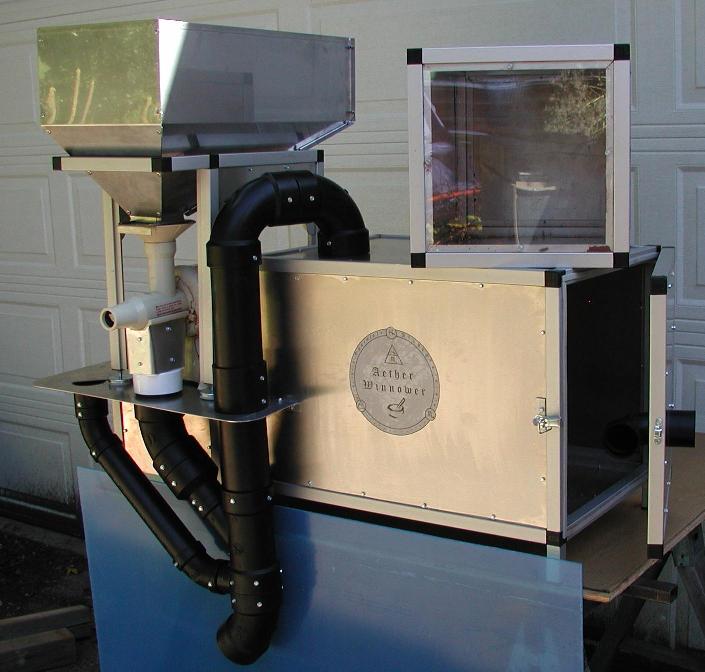
You tin can find more than information for the Aether here:
Sylph Winnower

Sylph Winnower
You lot can find more than information for the Sylph here.


Hither is a dainty overview of both the blow dryer method and using the Sylph.
And likewise more than information nearly doing it yourself (DIY)

Chocolate Alchemy'due south DIY Winnower
Chocolate Alchemy's DIY Winnower Function 1
Chocolate Alchemy's DIY Winnower Function 2
Chocolate Alchemy'south DIY Winnower Part 3
I need to point out that those were the first posts and plans, and equally y'all can run into in the photos to a higher place, the design has changed slightly. Beneath are MUCH improve.
What I need to point out is it is a hybrid of both winnowers, neither quite total sized Aether, nor smaller Sprite. It uses the larger PVC of the Aether, but the bones bucket configuration of the Sprite. Information technology shows no supports, and has purchased ball valves instead of the slider valves I have on the working models. Most important though it has the Discriminator air menstruation in the 'correct' place, namely fully under the bill/husk archway, instead of somewhat next to it equally in the outset blueprint.
You may exist saying to yourself, 'self, isn't that a PVC winnower that in a higher place he said didn't piece of work well?'. And I will respond, no. This has three critical differences:
- There is no long drop tube. Instead there is a deflector to stop the velocity of the nibs and husk, which was the but reason for a long tube.
- There is a Discriminator air menstruation beneath the nib/husk entrance. Honestly I am not 100% sure why it works from a physics standpoint (although I could constitutional and give some semi-one-half-baked ideas, but I won't), merely I do know it works with it, and does not work without it. 'nuff said.
- It'southward simple to operate.
Eventually there will be both total plans available. But there is more plenty information to make your ain, and I will always answer questions if you accept them.
Finally, for those that similar to encounter the progression of an invention, this is the Aether Winnower beginning to finish.

Grinding
Grinding
Grinding
Starting time off, wait to make a mess! It gets better with experience, but initially, cocoa will go everywhere.
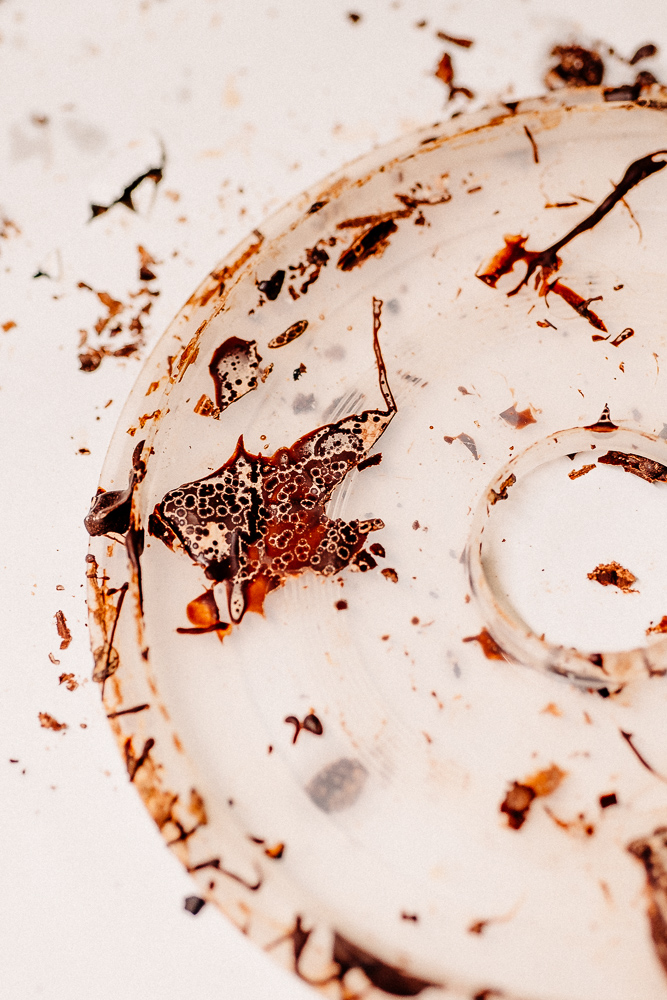
Await a MEss!
Later your cocoa beans take been roasted, and peradventure cracked and winnowed , the adjacent pace in chocolate making is to grind them until they liquefy into cocoa liqueur. Again, I have found many pieces of equipment that just are not up to this job. To proper noun a few, full general food processors, Vita-Mix, coffee grinders (burr and blade), meat grinders (transmission and electric) and mortar & pestles (nosotros are talking alchemy here later all) are merely are not sufficient to the chore at hand. I have heard that a Cuisinart juicer zipper can work, but most juicers will non work.
What does work remarkably well is the Champion Juicer. It grinds and separates the husks rather nicely. It does take a few of passes, and care must be taken not blitz, as the cocoa mass can get besides hot, and flavor can exist impacted. I have successfully done a four pound batch of cocoa beans in i/two hour. This may seem like a long time, but it really is non. Afterward y'all hit a routine, you tin can fifty-fifty be cleanup and take your chocolate into your Melanger and refining within an 60 minutes.
You want to feed the nibs into the Champion (with the fine screen on at present) a handful at a fourth dimension, using merely enough pressure on the tamper to feed the nibs in, just don't bare down - it volition just overheat the motor. Later two or 3 handfuls you should come across cocoa liqueur coming out of the bottom screen, and whatever husk is left coming out of the spout. Put all of your cocoa nibs through and collect the liqueur. Don't put it through the Champion again as information technology does not really do anything and but makes a mess.
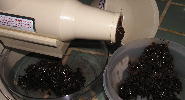

On the other mitt, y'all should now laissez passer the husk and cocoa liqueur that came out the spout back through the Champion. Each pass will allow more and more husk to be separated out until simply husk is coming out of the spout. If you accept winnowed well, you may not have any come out by the end.
I used to abet mixing in your other ingredients in at this point, but since we discovered the Melanger for refining, it really serves no point to add in your sugar. If you lot are going to put your chocolate straight into the Melanger or simply know how much extra cocoa butter yous are going to add (if you are adding any at all, it is optional), I practise propose putting information technology through the Champion now. What it will practise is free up the last of the cocoa liqueur that is in the Champion, and "flush" it out. A lot will come out the spout with more husk. Only pass information technology through over and over until all the cocoa butter is through the screen and "dry" husk it coming from the spout.
Every bit for how much cocoa butter to add, at that place are no hard rules about proportions or ingredient but here are some rough guidelines.
Carbohydrate content tin generally runs from anywhere from 20% (i.e. lxxx% cocoa, a rather bittersweet chocolate) all the way to lxx% saccharide (Hershey's). I have constitute 60-65% is a nice identify to start experimenting. Cocoa butter is not a necessity, just an option. It tin can run anywhere from 0-20%. At twenty% the upshot may be interesting and certainly milder, but too creamier. So far, I like 0-eight%.
Lecithin you volition discover in about all ingredient lists of chocolate. Every bit it says, it is an emulsifier and is ofttimes added at 1-2% of the actress cocoa butter you add. Not a lot. On the other manus, I accept 1 examination batch with ii% total added, and it definitely gave an extra silkiness to the chocolate. Bated from flavour and texture, the test batches with lecithin processed noticeably easier through the Champion Juicer. I utilise granular from a local health food store. I accept not tried liquid simply am told it works fine.
What does all this mean? Experiment! Commencement somewhere around 60% cocoa, 35% sugar and add together a little extra cocoa butter (5%, well-nigh an ounce for the batch sizes we are working in) and lecithin if you experience like it. Suit the recipes after than. Information technology will still be good regardless of what proportions you lot use.
Once it goes into the Melanger information technology starts out quite the ungainly mess, and looks similar it can not possible work, but Alchemy it is!
Conching and Refining
Conching and Refining
Conching & Refining
I have noted that in that location tends to exist some confusion when people talk near conching and refining chocolate. It probably does not assist that I have even put the two processes on the same page. But I want y'all to understand that they are two separate processes with two different goals in mind. Sometimes conching and refining can happen at the same time, but they practice not take to and often you lot practise not want them to. Some definitions are probably in order. Conching Conch comes from the Spanish word concha, which means beat out. The name "conching" arose because the original vessel used to hold the chocolate was shaped similar a conch trounce. Conching is a modern process used in making chocolate The feature gustatory modality, smell and texture (and by this, I mean general mouthfeel, non particle size) of chocolate are developed at this stage.
Refining

The procedure of reducing the particle sizes of both cocoa solids and carbohydrate crystals in finished chocolate. The goal is somewhere in the range of xv-25 microns. Your tongue loses its ability to make up one's mind texture and grittiness at around 30 microns. Under about x microns the chocolate can become mucilaginous. We will worry virtually over refining when nosotros go there. Nosotros can only hope for that problem.

With that all said, what we have found that works remarkable well for both Refining and Conching is the Spectra 11 (previous known as the Alchemist's Rock Melanger). If you notice, information technology looks a lot similar a commercial old fashion Melangeur.
On a weekly footing I get asked if there is another less expensive mode to refine chocolate at home. Trust me (hopefully you do), if I knew of one, you would know about it. Correct now, to the best of my knowledge, the Melanger is it for small scale (one-50 lbs). Although the list is by no ways conclusive, dissimilar things nosotros take and failed to utilize as chocolate refiner are as follows:
- Water ice cream maker
- VitaMix
- Cuisinart
- Blenders (many makes and models)
- Juicers (including the Champion, which is the just juicer nosotros know of that will liquify the cocoa nibs, just still doesn't bear on sugar)
- The oh and so romantic Mortar and pestle
- Ball mills (homemade they were just too expensive)
- Rock tumblers (with steel shot)
The Spectra melanger has a heavy motor that rotates a granite slab (10 lbs) and 2 large heavy (7.25 lb full) granite rollers at most 150 rpm. The whole thing is just under 50lbs! Oh, and I just saw they say it is "lite weight" - don't you believe them - this thing is a heavy duty monster - and that is peachy! Actually, the pictures just do not due it is justice. Just take a expect.
So, how do you use the Melanger?
I suggest pre-heating the bowl and rollers. Don't go over 150 F equally the epoxy can fail.
Cook any cocoa butter y'all are going to add together. Anywhere from nearly 120 F on up to 250 F.
If you are using liquor, melt and add it. If yous are using nibs, heat them to 120-150 F and add them in pocket-sized handfuls, giving the Melanger time to grind them downwardly. Add more as information technology gets smooth. Yous tin add your pre-heated sugar at this bespeak too. In that location is no need to pre-grind your saccharide. Regular granular sugar works great. NOTE: Exercise not add Whatever water based ingredients to your chocolate in the Melanger. The chocolate will seize and you tin can harm your Melanger. After the first hour though, the chocolate becomes more liquid like and the whole affair generates plenty heat by friction that additional oestrus is not actually needed. Afterwards that, I take found a difference in texture after every 60 minutes, with "smooth" chocolate occurring around 10-fourteen hours. With the freshness and quality of ingredients we are using, I have found no degradation in flavour or signs of over-refining after 24 hours of refining and I have word from various customers that it performs smashing upward to 36 hours (non that in that location is a problem subsequently that, just that they refined that long). It is that simple.
If you need to terminate the refining, only do. Information technology will not hurt a thing. I plough mine off at dark, put the bowl into a pre-heated oven (about 150 F, with the oven then turned off) and let information technology set overnight. It is ordinarily even so liquid in the morning and I tin just restart the refining. If information technology does solidify, just turn the oven on nearly 150-175 and melt the chocolate. Accept the comprehend off for better heat transfer and so you lot don't melt it. Finally, the bowl is held together my an epoxy that has a maximum temperature limit of almost 170 F. It tin handle a 200F for a brusk fourth dimension, just don't let everything get that hot.
My latest batch of chocolate was two pounds of milk chocolate.
8 oz Ghana Forastero liqueur (melted) (20%) 8 oz cocoa butter (melted) (xx%) 8 oz not-fat dry milk pulverization (twenty%) xvi oz sugar (40%) 2 g lecithin (0.ii %) one/ii vanilla pod (split and soaked in the cocoa butter 1 hour)
After refining for x hours, at 1 hour increments, there was no noticeable grit left from the saccharide. During that fourth dimension, some conching occurred to - there was a marked increase in viscosity (which is what is supposed to happen) and some of the sharper flavors at the start have mostly disappeared. Conching has to occur to some degree equally there is tremendous shear where the 120 rpm granite rollers rotate against the lower spinning granite slab.
This is the chocolate as it simply went into the Santha
.

Later on nigh 5 hours y'all can see most of the grit has been refined abroad, but you should note that at that place is not a lot of gloss to the chocolate. It means is it not ready yet.

This is the chocolate all finished. There is a nice high gloss, and you can even see the chocolate sort of spinning off of the granite rollers.
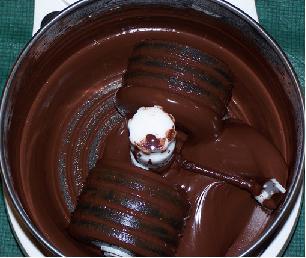
Of form, the real test of whether it is done or not is "do y'all like it?" and "is it smooth enough?". Only you can answer those questions.
In addition to the above basic instructions, there is as well the Chocolate Melanger Instructions and tips which give a bit more detail on how to utilize (and not abuse) the Melanger.
In the mean fourth dimension, the following will requite y'all a bit more item as to what in involved in refining and conching.
Refining and(vs) Conching
Conching
The process involves heating and mixing for several hours to several days the ingredients of chocolate - cocoa, cocoa butter, sugar, lecithen and and any "flavoring" such every bit vanilla or essential oils. For milk chocolate, dry milk powder is likewise included in the mix. (don't try to apply liquid milk, it will seize on y'all). During conching, the chocolate is heated to temperatures of 110 to 180 F, sometimes externally, sometimes merely from friction. In the "industry" many Milk chocolates are heated to temperatures over 160 F to let the lactose crystals to transition into baggy lactose. This transition is often why milk chocolate has that soft and silky mouth experience. Some people (both commercial and at dwelling) don't do this, and that is fine. Especially at home, it is your option. I find the 140 F often reached in the Melanger does only fine. Regardless, during Conching the abrupt taste of the fresh cocoa slowly disappears. At the same time the acidity and bitterness of cocoa are lost and the moisture content is reduced (there is actually contend over this) and the delicious chocolate flavour becomes fully developed. Simultaneously in the process, the smoothing of the cocoa and sugar particles takes place with cocoa butter forming around each of the small particles. This is dissimilar from refining really. The particles of sugar and cocoa are smoothed out in conching but non substantial reduced in size. Conching is done for several hours or up to 3 days. Finally, there are basically two thoughts on conching - low and high shear. When conching was discovered, in that location was merely low shear, and this is probably why it could take up to 3 days. With modernistic equipment, there take been a number of conching advancements, notably high shear conches. These supposedly (there over again is great fence) tin conch a batch of chocolate in under 15 minutes. The loftier shear causes the volatile components to be quickly liberate from the cocoa mass.
There is no existent correct way or amount of fourth dimension to conch. Information technology is up to you and what you want your last chocolate to be like. All I can do is requite you lot certain guidelines. Certain Criollo cocoa beans are chosen because they are bright and fruity. You would not actually want to conch that for 3 days because you lot are merely going to bulldoze off those qualities that you choose the bean for in the kickoff place. And yous volition need to keep residue in mind in that desirable and undesirable compounds are driven off during conching. The trick is to detect that combination of conditions (depression or high shear, high or low estrus, curt or long time) that give the chocolate flavour you desire. Conching is probably the least understood process in modern chocolate making and consequently the most Alchemical of the processes. Finally, endeavor not to worry too much over it. Even if you lot chocolate is not exactly similar to want it, it is nonetheless going to be skillful, primarily because you are using fresh quality cocoa beans.Right at present at that place are no heated dwelling house conchs, only the Santha that conchs equally it refines. The present plan is that nosotros can further modify the Santha to be heated. Nosotros are working on that and volition go on everyone upwards to date.
We have come up a long way since Chocolate Alchemy started. You if want, you can go read some of the History.

Tempering and Molding
Tempering and Molding
Tempering and Molding
Why atmosphere chocolate? It is what gives the chocolate bars y'all swallow that finished glossy, shiny appearance and that nice snap when you eat it.
If you don't actively temper your chocolate, you might get lucky or you might not.

Untempered
-Unstable
-Matte
-Melts easily
This is of a piece of chocolate that is not tempered. Information technology has simply a matte advent, is soft and melts readily if you try and choice information technology up. Later on a couple of days untempered chocolate tends to "bloom".
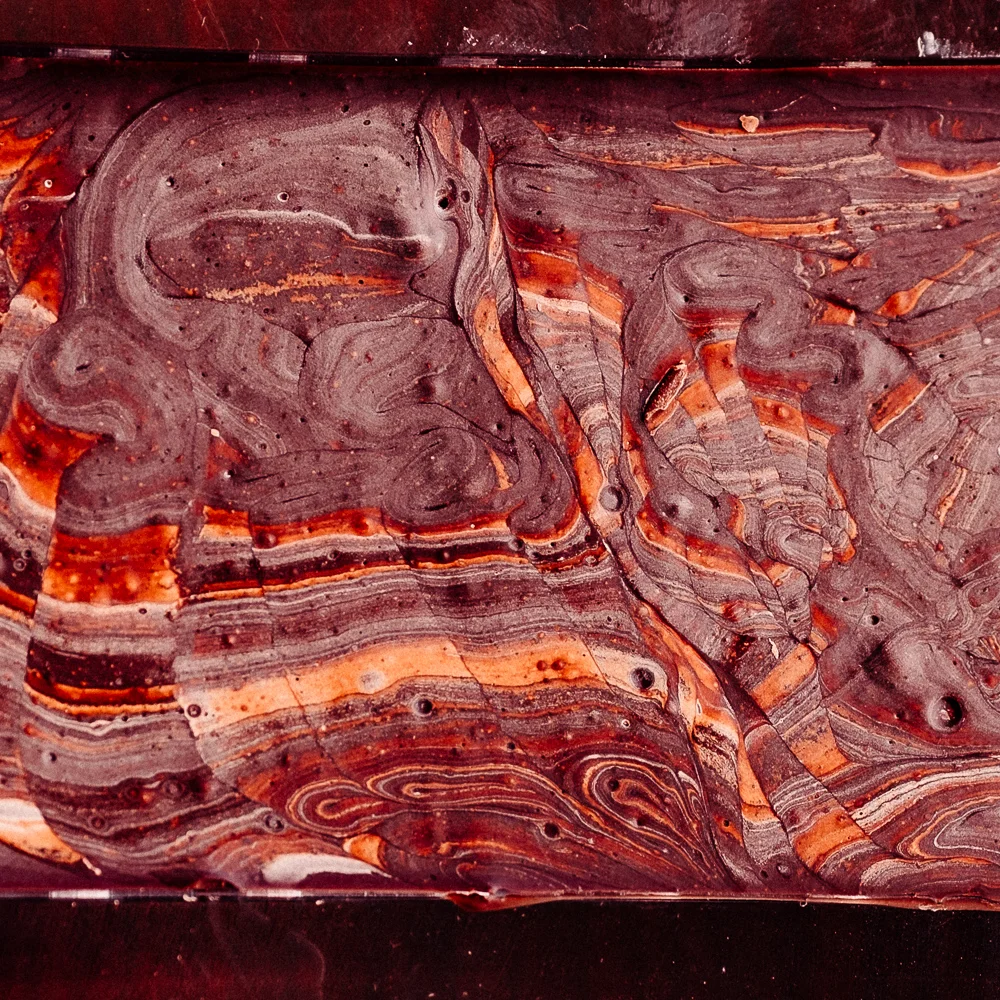
Bloomed
-Coarse
-Unstable
This is Bloom. It still tastes fine, but I discover the texture of bloomed chocolate a trivial odd. Kind of coarse.
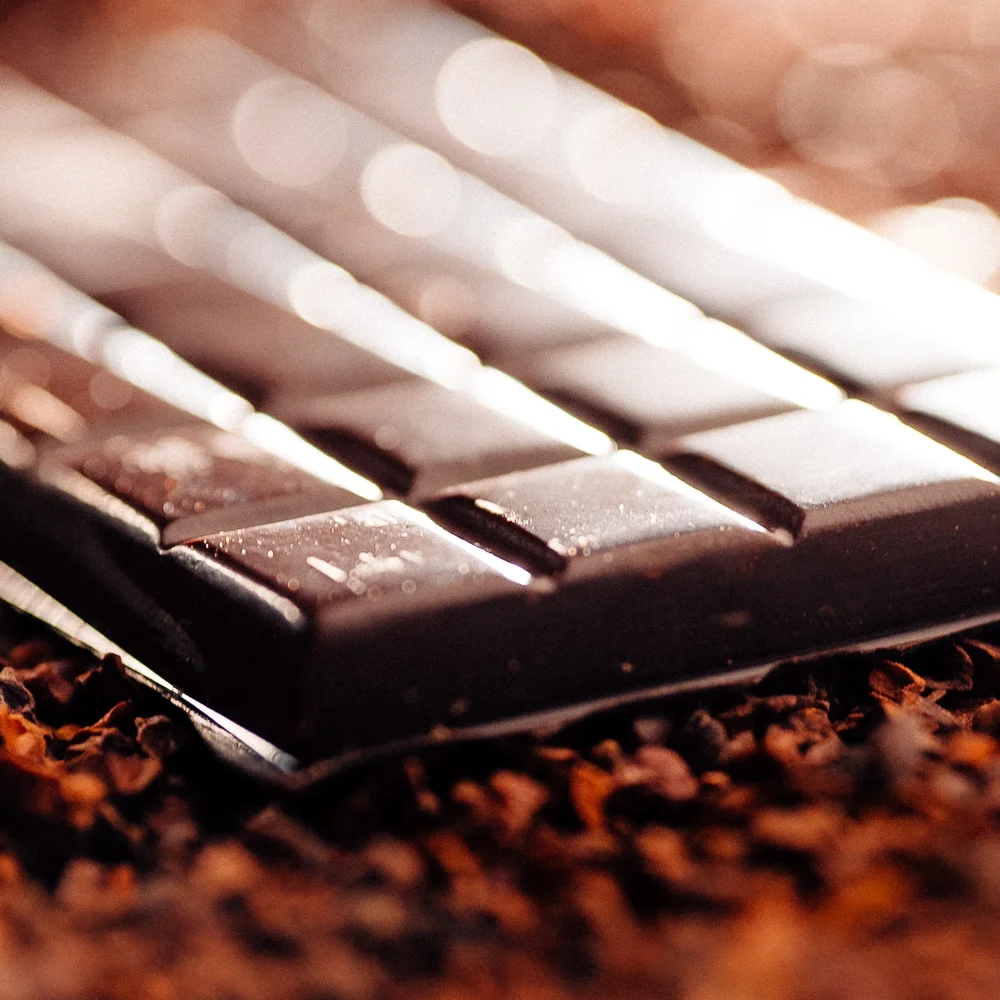
Tempered
-Stable
-Shine
-Snap
Finally, this is tempered chocolate. It has a squeamish shine, snaps when y'all break it, and does not melt as y'all are trying to choice it up.
Tempering involves bringing your Alchemical chocolate creation to a temperature at which the cocoa butter reaches its nigh stable form—which conveniently is a course humans like to eat and humans eating our chocolate is why we make it, but also why nosotros larn the dark art of tempering.
Related Reading
In case you lot ever wondered what is actually happening inside your chocolate during tempering.

A pair of articles helping you fully understand the critical science behind Tempering

What is Cocoa Butter Silk? Why should you care? and how does it make tempering chocolate easier?

A lot of people have questions about water and Making Chocolate
A few words about moisture and chocolate
Chocolate will crystallize (incorrectly) if whatever wet gets in it. When tempering chocolate, you must keep your chocolate dry at all stages, later on all, you but spent days refining it to remove the water.

Just look what a little bit of water can do!!! If you really become into making chocolate, it might exist worth it to consider purchasing a chocolate tempering machine although I personally prefer the hands on process. These appliances take much of the guess work out of tempering.
How to Temper Chocolate
There are lots of ways to temper chocolate and they are all over the internet. And the details can vary quite a bit.
Here are a few nuts that everyone should know that hopefully lets y'all relax about some of the details
-
You tin can atmosphere over and over. If your chocolate blooms, it is not ruined. Just melt it again and start over.
-
Yous may come across you need to melt your chocolate anywhere from 100 F to 135 F. Anywhere in at that place volition work.
-
You will not burn your chocolate even if it gets above 160 F. Many milk chocolates refine that hot. What is important is that you use a double boiler to heat your chocolate. Heating chocolate directly in a pan over rut can indeed burn down chocolate because the surface of the pan, even on low, can get above 300 F.
I recommend tempering in bowls. There is cipher special about using a machine, or a marble slab. I find I take more than control with bowls and can work without rushing.
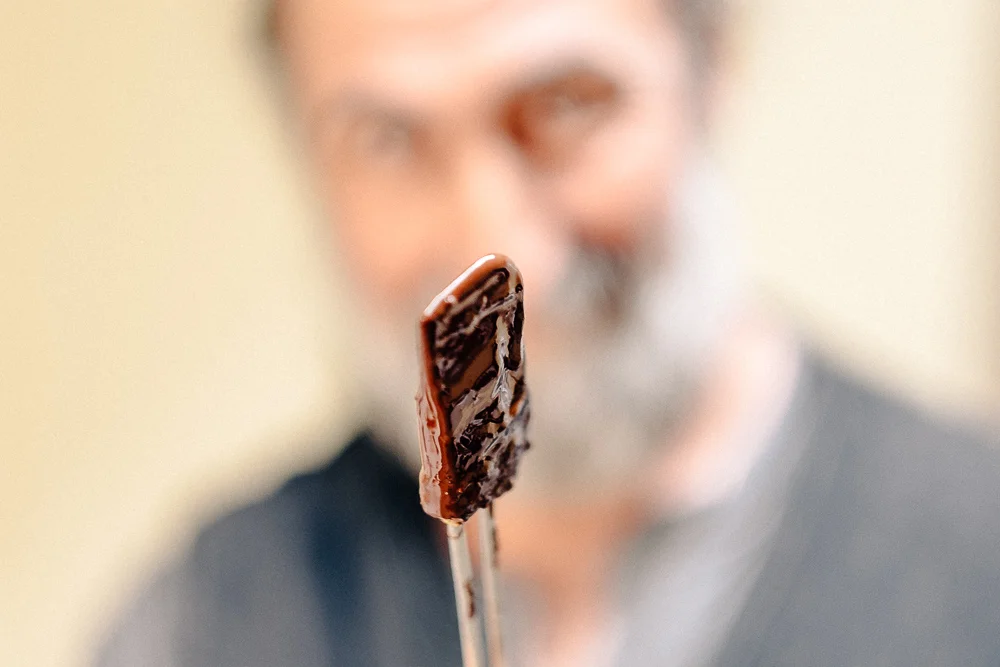
An Overview
Melt your chocolate in a double boiler until the chocolate is at least 105 F.
Pour almost 2/three into another bowl. Set the other 1/3 to the side and keep it warm.
Stir the 2/3 portion until it starts to thicken. This happens almost 79-81 F. The thickening is a sign you take created seed.
Slowly add parts of the warm chocolate to the cooler, seed chocolate.
Practice information technology fiddling past little until the temperature is 88 F (86 F for milk chocolate).
Pour up into molds and allow set up up.
Unmold and enjoy
Now the details. Permit's do this.
But First, On Why You demand a good thermometer
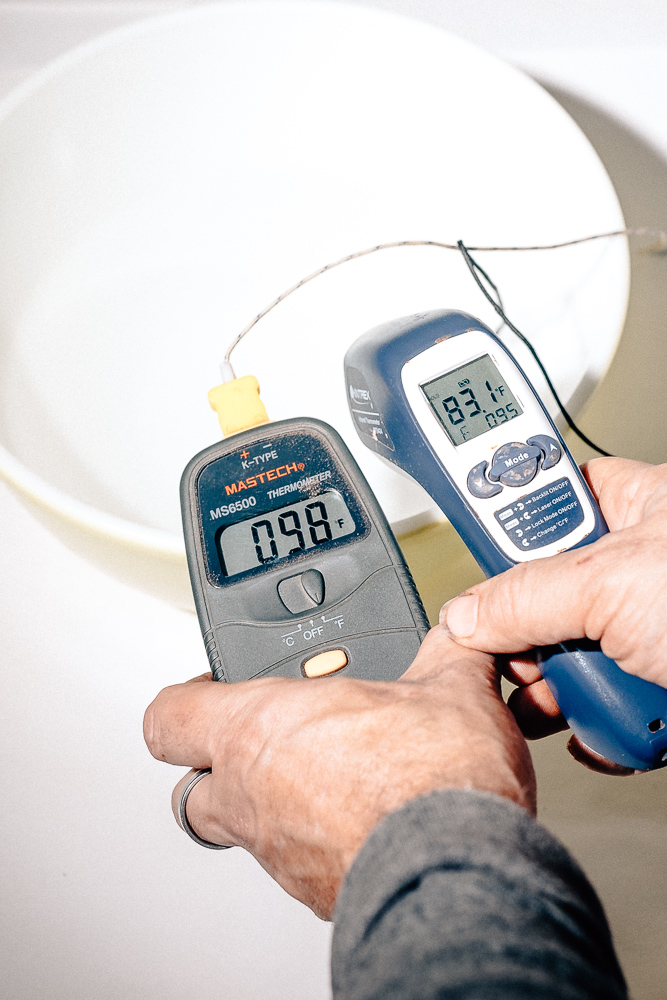
Why you need a Probe Thermometer
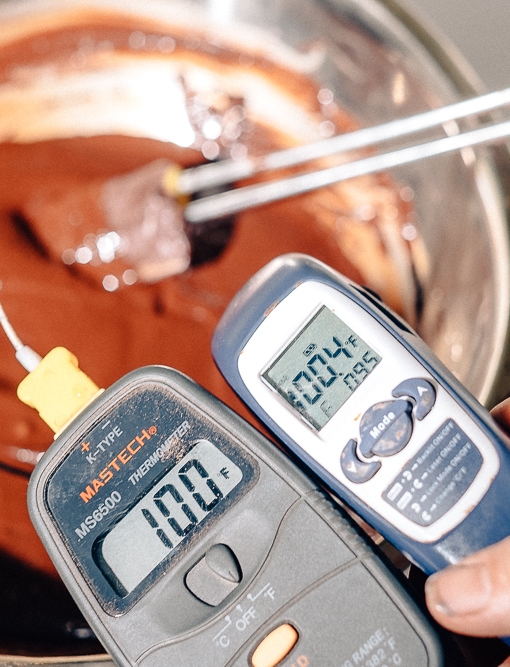
They should read the aforementioned temperature.
The kickoff thing is you lot demand a good thermometer. 1 where you tin can run across ane F increments. That means no candy thermometers. The just are not accurate enough. Too, you cannot use IR or laser thermometers on the water. You demand a probe thermometer for that. The light amplification by stimulated emission of radiation needs something to bounce off and h2o screws information technology upward. Have a look (left picture, note the differences in temperatures).
Y'all can of course utilize either for chocolate and I personally similar a light amplification by stimulated emission of radiation thermometer.
Other items you lot volition need:
-
4 bowls that nest together.
-
Towels
-
Spatula
-
Molds
-
Double boiler/pan
Tempering Temperature Charts
Fahrenheit
* If the Silk is solid and y'all grate it, 95 F. If you are stirring in softened Silk, yous bring it on down to your working temperature
** The cooling point of all chocolates is until information technology slightly thickens. That is more important than an actual temperature
*** coconut oil inhibits spontaineous tempering and can only be done with Silk.

Tempering Step past Step

Step 1
Melt your chocolate in a double banality until the chocolate is at least 105 F.
You don't demand an official double boiler here. Just a bowl on peak of a pan was warm to simmering water. Over again 105-130 F is just fine. The higher you become but means you have to wait longer for it to cool to a reasonable temperature before you can use information technology.
Key Understanding:
Chocolate or more specifically cocoa butter forms 5 different types of crystals. Our goal in tempering is to make one called Type Five. Heating the chocolate higher up all of the melting points gives yous a make clean slate to work with.
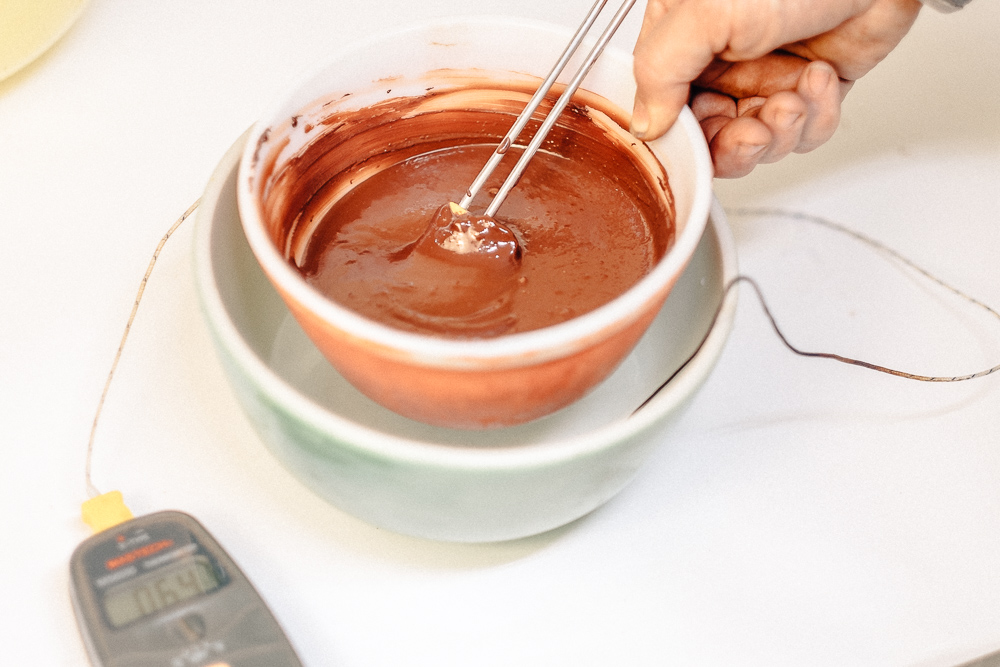
Step 2
Cascade virtually ii/3 into some other bowl. Fix the other ane/three to the side and go on it warm.
I find it very helpful to put my basin of warm chocolate into a bowl that contains warm water. 90-95 F. Remember, utilise a probe thermometer, not an IR or laser..
As well, put the other chocolate into a h2o bath that is cool. sixty-seventy F works well.
Key Understanding:
H2o baths aid either proceed the temperature stable or motility the temperature in the direction you need information technology to go. Make sure the lip of the inner bowl is higher than the outer bowl or water may spill into your chocolate.


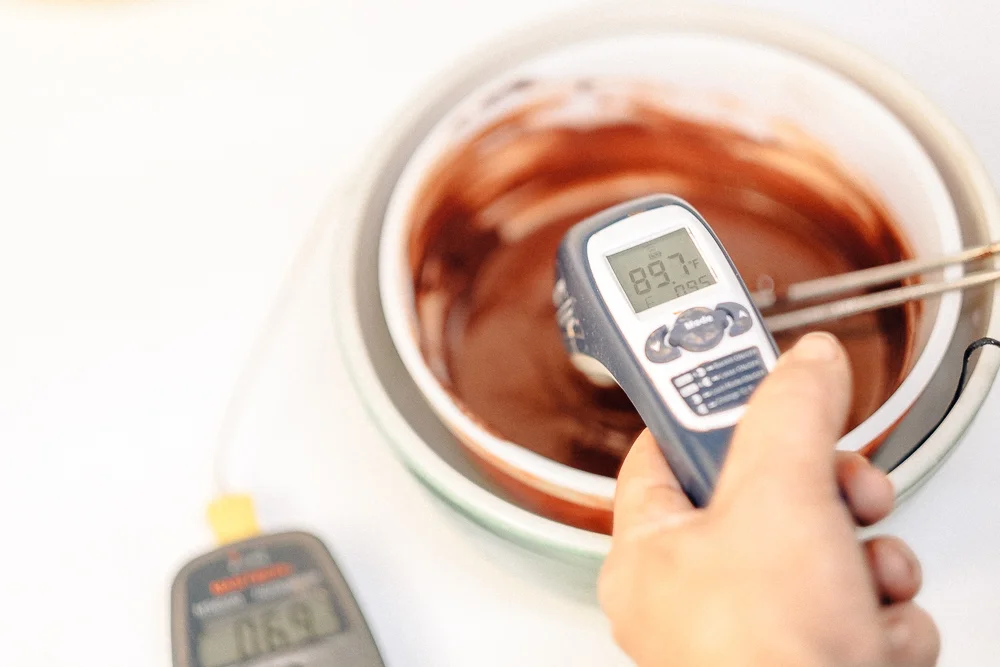
Step iii
Stir the 2/3 portion until it starts to thicken.
This happens about 79-81 F. The thickening is a sign you have created seed. You may also hear it referred to equally cooling until the chocolate traces.
Notation: If you lot happen to cool your chocolate too much and information technology gets very thick, nothing is ruined. It is simply harder to work with. Just stir in a niggling of the warm chocolate y'all have in to arrive workable, or modify water baths so the thick seed chocolate is in the warm one. Once information technology is workable, just go on as normal.

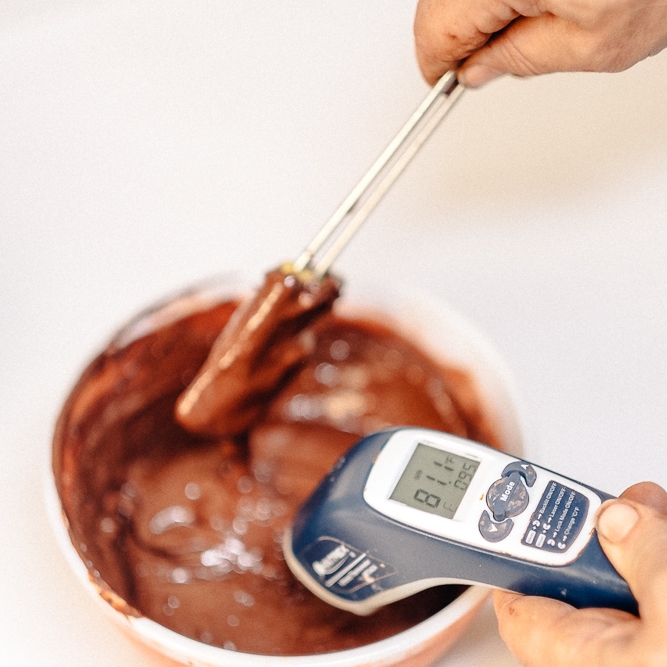
Central Understanding:
At this bespeak you have created Blazon Four and Blazon 5 crystals. When y'all cool chocolate both naturally class at the aforementioned time. The thickening is the sign you take plenty Type V to ensure a practiced temper. The exact temperature does not matter. It is often helpful to still have a thermometer handy to run into how close you are getting.
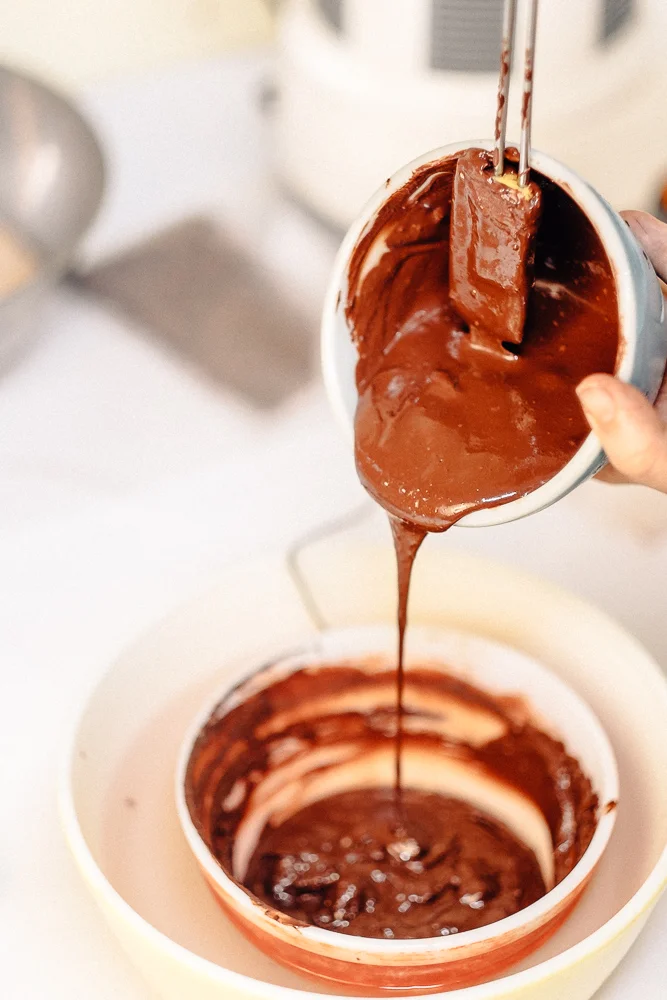
Step iv
Slowly add together parts of the warm chocolate to the cooler, seed chocolate.
Your initial goal here is just to heighten the temperature a fiddling then the chocolate is easier to work with.

Step 5
Do information technology picayune by picayune until the temperature is 88 F (86 F for milk chocolate).
Key Understanding:
At 88 F only Type V crystals can survive. The Type IV that yous created when cooling will melt. Now that at that place is only Type V present, the chocolate has a scaffolding to build upon and the chocolate will crystalize properly giving y'all tempered chocolate.
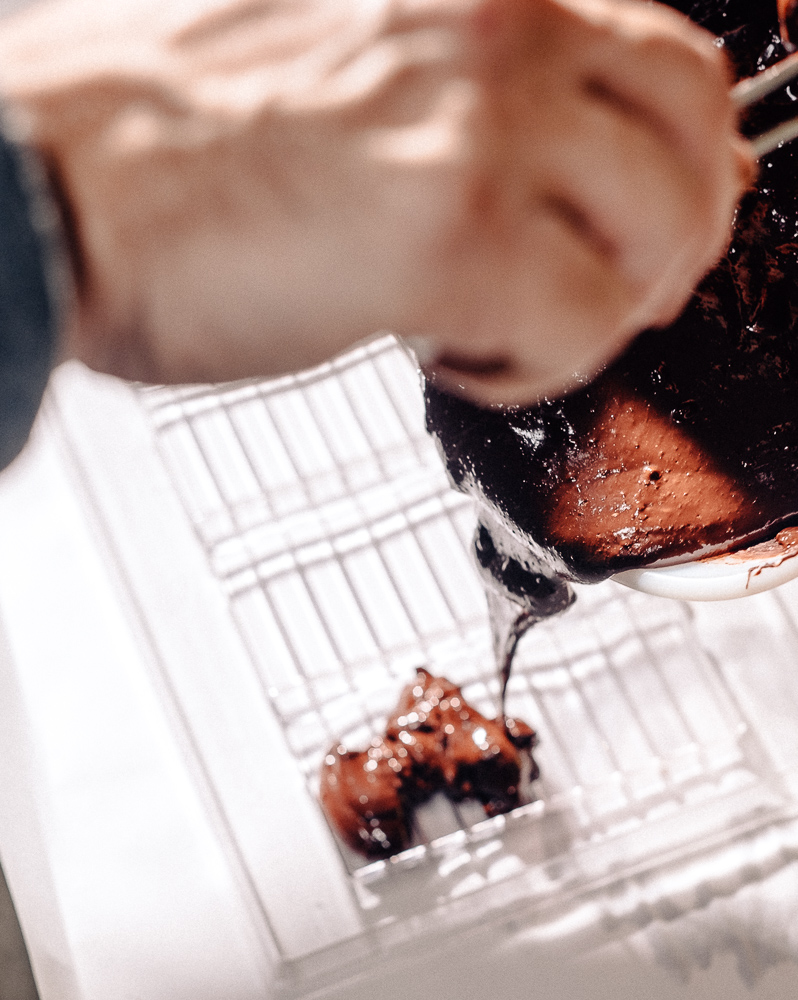
Stride half-dozen
Cascade up into molds and let gear up upwardly.
Pointers for Success:
Pour directly from the bowl into your molds.
Make certain you wipe the bottom of bowl so no water drips in.
Utilise a large ladle. Practise your best not to utilise more than than one scoop per cavity.
Multiple fillings of the same cavity tin lead to surface bloom

Step vii
Rap the molds on the tabular array to settle the chocolate.

What to practice if you over pour?
Don't scrape the chocolate off at all possible. If you must scrap because y'all poured too much, practice information technology only one fourth dimension and so rap the molds once again.

Key Understanding:
Crystals are fragile. Scraping and disturbing the chocolate while it is setting up can disrupt the crystals. These disrupted crystals tin lead to bloom.
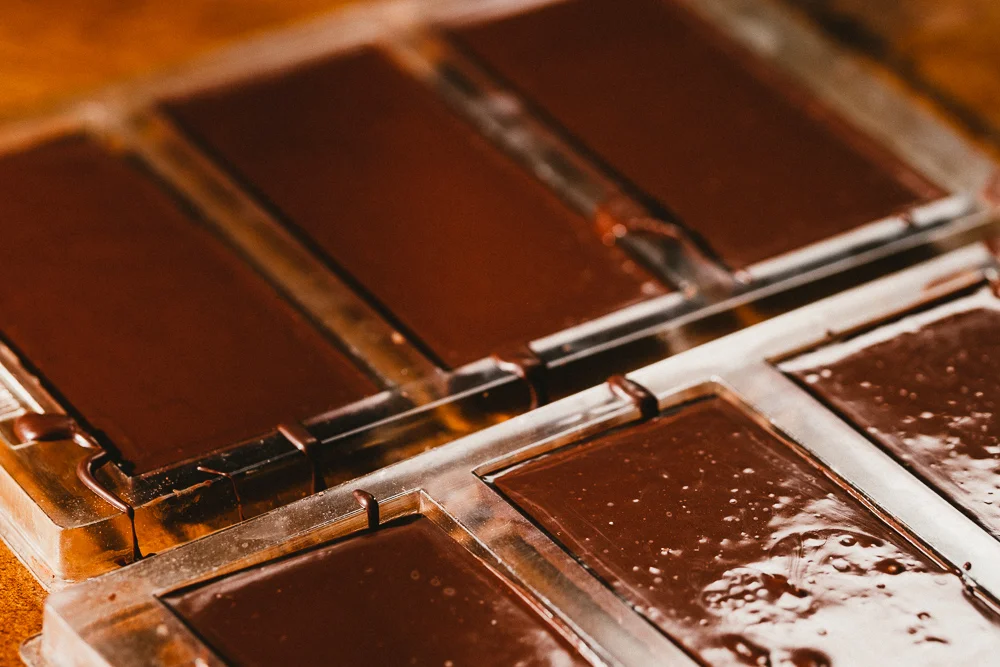
Step 8
Unmold and relish.
Look a few hours for your chocolate to fully absurd and temper. Then briskly plow the molds over and y'all chocolate should pop correct out.
I don't recollect I need to tell you how to enjoy the chocolate.

Odds & Ends
To refrigerate or not. This is a lilliputian of where the art and scientific discipline comes into play. Some people swear past it, some find it causes problems. Hither is what I tin tell y'all.
If you take a lot of Type V crystals and your room is on the cooler side (under lxx F), you probably don't demand to air-condition at all. The crystals volition build upon each other merely fine and your chocolate volition temper perfectly.
If yous are a fiddling depression on Type V crystals, or the temperature is a fiddling warm (above 75 F) you lot probably want to put your chocolate into the fridge for 5-10 minutes. But sentry out. If they are in too long or information technology'southward too cold you tin can rush the temper, causing information technology to be unstable and bloom volition be the result later it comes out of the refrigerator.
What to practise if your room temperature is 70-75 F? My recommendation is to endeavor and let your bars set up up at room temperature. If it works and they temper, you are adept to go.
If you find they are a little irksome to prepare or you have minor bloom issues, permit them set at room temperature four-five minutes. Then put them into the refrigerator once again for nigh five minutes; just enough to kick kickoff the procedure. Then permit them finish setting up at room temperature.
I mentioned before there are lots of means to temper and fashion more than to tempering.
Cheque out the links below for more.
Ane of my favorite ways is using Cocoa butter Silk:

The care and feeding of your cocoa butter Silk
A deep read on the scientific discipline of tempering:

A pair of articles helping you fully empathize the disquisitional scientific discipline behind Tempering
Now, Get Brand Some Chocolate!
Boosted Reading on Tempering:
Now, Go brand some Chocolate!
Source: https://chocolatealchemy.com/how-to-make-chocolate-the-complete-text-guide

0 Response to "How To Make Chocolate In Little Alchemy"
Post a Comment